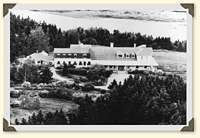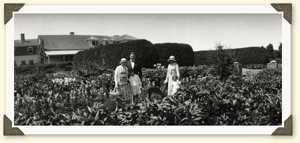
| In 1886 George Stephen began acquiring property along the Metis
river. He bought the Pointe aux Cenelles and acquired the riparian
rights along the Metis river from farmers whose lands bordered
the river. The fishing lodge was completed in 1887 to the designs
of an architect who was paid $180, but whose identity is unknown.
George Stephen baptised his fishing camp "Estevan Lodge", taking
the name from his telegraph cable code. The total cost of the
property, buildings and improvements was $73,426, the house alone
costing $38,109. |
| Stephen spent several weeks every summer at Grand-Metis making the journey from Montreal in his private rail car "Mitipedia". Even after he retired to England, Stephen returned to Canada to fish at Grand-Metis. On his visits, he would stop to see his friend, Prime Minister Sir John A. Macdonald, at his summer house at St. Patrick (near Rivière du Loup). |  |
| His guests at Estevan included his partners and fellow railway
magnates, J.J. Hill and Donald Smith. But after the death of his
wife in 1896, Stephen never returned to Metis. He had never fished
without her at his side and he could not bear to return to the
river without her. He loaned the house and property to his brothers
and sisters and to his many nieces and nephews. New Yorkers James
Stillman and Percy Rockefeller used the fishing camp every summer
as did Gaspard Farrer, a partner in the London investment bank,
Baring Brothers, which Stephen had rescued from bankruptcy in
the 1890s. His other regular tenant was John Sterling, the founder
of the Wall Street law firm of Shearman and Sterling and a partner
with Stephen and Smith in several railway ventures. Sterling died
in Estevan Lodge on 5 July 1918. Lord Mount Stephen gave Estevan Lodge and adjoining properties to his niece, Elsie Reford in October 1918. She added to the property, buying several nearby farms and riverside lots to protect the river from poaching. She reluctantly sold the falls at Price to the Lower St. Lawrence Power Company and forced the company to respect strict measures to prevent the pollution of the river and the constant flow of water to protect the salmon habitat. Elsie Reford frequently had guests to stay at Estevan Lodge and fish on the river. She frequently hosted her children and grand-children, her sister-in-law Kate and her husband, Colonel W.H. Clark-Kennedy, V.C., her brother-in-law Dr. Lewis Reford, McGill professor Dr. J.W.A. Hickson, and her friends Muriel Galt, Sybil Grey, and Daisie Campbell. She entertained governor-generals Lord Grey, Lord Byng, Lord Willingdon, Lord Bessborough, the Count and Countess of Athlone (Princess Alice), and Lord Tweedsmuir (the novelist John Buchan) over four decades. |
 |
Estevan Lodge has undergone many changes over the years. In 1926, Elsie Reford commissioned the Montreal architect, Galt Durnford, to design additions to the front and back of the house. |
| She added two bedrooms and bathrooms and a sitting room for she
and her husband, including such novel features as picture windows
and a hot air furnace. She also added a dark room and sewing room.
The kitchen and domestic quarters were also expanded, and the
windmill was demolished to make way for a pantry and laundry.
The expansion cost $30,000. The laundry was transformed into a
garage in the 1950s by Bruce Reford . It was restored to the
original design of Galt Durnford in 1996 and now houses the garden
shop. During the 1960s and 1970s, the interior of Estevan Lodge
(by then re-baptised the Reford Villa) was altered. The ground
floor bedrooms were modified by the demolition of dividing walls
and were transformed into public rooms. The basement was excavated
and the structure of the house was solidified by replacing the
rotten wooden pillars and joists with steel beams. Today, Estevan is fully used by tourists. It houses a dining room and restaurant and Les Ateliers Plein Soleil handicrafts boutique. The second floor is dedicated to a series of museum exhibits on the Reford family and the gardens and exhibits of local history. |
      
|